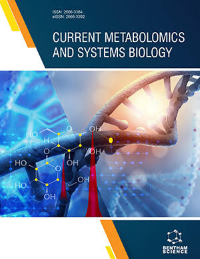- Home
- A-Z Publications
- Current Metabolomics and Systems Biology (Discontinued)
- Previous Issues
- Volume 8, Issue 1, 2021
Current Metabolomics and Systems Biology (Discontinued) - Volume 8, Issue 1, 2021
Volume 8, Issue 1, 2021
-
-
Cell Culture Studies: A Promising Approach to the Metabolomic Study of Human Aging
More LessAuthors: Ana Rocha, Sandra Magalhães and Alexandra NunesWith the increasing aging of the world’s population, a detailed study of the characteristics of aging, and the pathologies related to this process, are crucial to the development of targeted anti-aging therapies. Therefore, there are several study models for the study of aging, from computational models to animals or even to cell cultures. The latter have shown high potential for aging studies as they are easier to handle, cheaper, Read More
-
-
-
A Roadmap of Cancer: From the Historical Evidence to Recent Salivary Metabolites-based Nanobiosensor Diagnostic Devices
More LessAuthors: D. Durgalakshmi, R. Rishvanth, J. Mohanraj, P. Aruna and S. GanesanThe etymology of the term cancer for a dysregulated balance of cell proliferation and cell death may be of the recent centenary. But the occurrence of cancer was reported at various periods in the history. Even though research towards a cure for cancer has received higher interest in various scientific domains due to its need for mankind, appropriate therapy for the complete cure of cancer is yet to be resolved by t Read More
-
-
-
Comparison of Different Sample Preparation Techniques for Untargeted Metabolomics Utilizing Q-TOF LC/MS and MetaboAnalyst 4.0
More LessAuthors: Ozan Kaplan, Engin Koçak and Mustafa ÇelebierBackground: Profiling the whole metabolome with a single injection is not an easy process because the chemical and physical properties of metabolites are totally different with each other and the analytical methodologies and data mining procedures need lots of effort to make such an approach in real. This reality leads researchers to select an already applied methodology for metabolite profiling and analyze the sampl Read More
-
-
-
Metabolite Profiling of Different Solvent Extracts of the Microalgae Chlorella vulgaris Via 1H NMR-Based Metabolomics
More LessAuthors: Hamza A. Pantami, Khozirah Shaari, Muhammad S.A. Bustamam and Intan S. IsmailIntroduction: In the present study, profiling of the cultured Chlorella vulgaris metabolome was carried out via1H NMR metabolite profiling of 6 different solvent extracts. The results indicated that the six solvent extracts have metabolite profiles that are clearly different from each other. Methods: Multivariate data analysis (MVA) reveals that ethyl acetate and ethanol extracts were well separated from the aqueous extract Read More
-
Volumes & issues
Most Read This Month
Article
content/journals/cmsb
Journal
10
5
false
en


